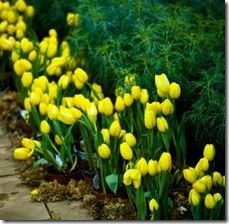Crocuses, daffodils and tulips announce the arrival of spring each year. Tulips require a period of cold temperatures to initiate root growth. When the weather warms up in the spring, tulip bulbs will send up stems and flowers in every color of the rainbow. Whether you prefer a shot of color in a pot from deep red tulips, a cluster of happy yellow and orange tulips near a mailbox, or an entire yard full of flowering tulips, they are a snap to grow if you plan ahead.
Tulip Blooms
-
Tulips require a cold period of at least 15 weeks. During this cold period, tulip bulbs begin growing roots. When the weather begins to warm in the spring, the tulip bulb will send up shoots of leaves, followed by the stem that will hold the bloom. Tulip bulbs are classified as early, mid-season, and late flowering. Early tulips will bloom when the weather is still a bit cool in the spring, at about the same time daffodils bloom. Late-flowering tulips help the garden transition from spring to summer before dying out.
Tulip Growth
-
Plant tulip bulbs in the late summer or early fall, when temperatures start to cool down. The roots of the bulbs will begin to grow throughout the fall, pausing during very cold temperatures. As the weather warms up in the spring, shoots will push through the ground, followed by tulip flowers. After the flowers bloom, the leaves of the plant will continue to photosynthesize. This provides the bulb with food and energy for the next blooming cycle.
Forcing Bulbs
-
Forcing bulbs manipulates the tulips into believing it is time to grow. Plant tulip bulbs in a container filled with a mixture of sterile potting mix and perlite, putting the flat part of the bulb facing the outer part of the container. Fill in with soil, but do not cover the bulbs with the soil. Water in the bulbs, then place them in a cold place to simulate winter for at least 15 weeks. You can put them outdoors in the winter, in a refrigerator, or in an unheated garage. Check soil regularly to maintain moisture, but do not over water. When the cooling period is over, bring the pots indoors and place in a cooler location for a few days, until shoots appear, then move to a warm, sunny location. They will believe it is spring and send up shoots and flowers.
Tips
-
Mulch tulip beds after the ground has frozen in the winter. Remove mulch in the spring after the shoots are 1 inch out of the ground and add fertilizer. Flowers may be cut, but allow leaves to remain if you want to save the bulbs for next year. Do not remove the leaves until they are yellow and easily removed, because the bulb needs the leaves to store food and energy for the next year. Bulbs can be dug up after the leaves turn yellow, or can remain in the ground for the next year.


Deprecated: strpos(): Passing null to parameter #1 ($haystack) of type string is deprecated in /home/agriviek8Qv/agriviet.net/public_html/wp-includes/comment-template.php on line 2522